Developing a Business Plan for Solar Powered Transport Vehicles
VerifiedAdded on 2022/10/15
|11
|2250
|13
Report
AI Summary
This report details a comprehensive business plan for solar-powered transport vehicles. It begins with an industry background analysis, highlighting the challenges of the existing transport sector, particularly environmental pollution, and presents the opportunity for solar-powered vehicles. The report outlines a high-level solution involving solar panels and efficient batteries, a business model focusing on revenue generation through vehicle bookings, and a gap analysis emphasizing the environmental benefits. It includes competitor analysis, a unique value proposition centered on clean energy, and an ideal customer profile. A total addressable market analysis and a business model canvas are also presented, including key partners, activities, resources, and revenue streams. The report concludes with value proposition canvas, summarizing the key benefits and features of the proposed business. The document is contributed by a student to be published on the website Desklib. Desklib is a platform which provides all the necessary AI based study tools for students.
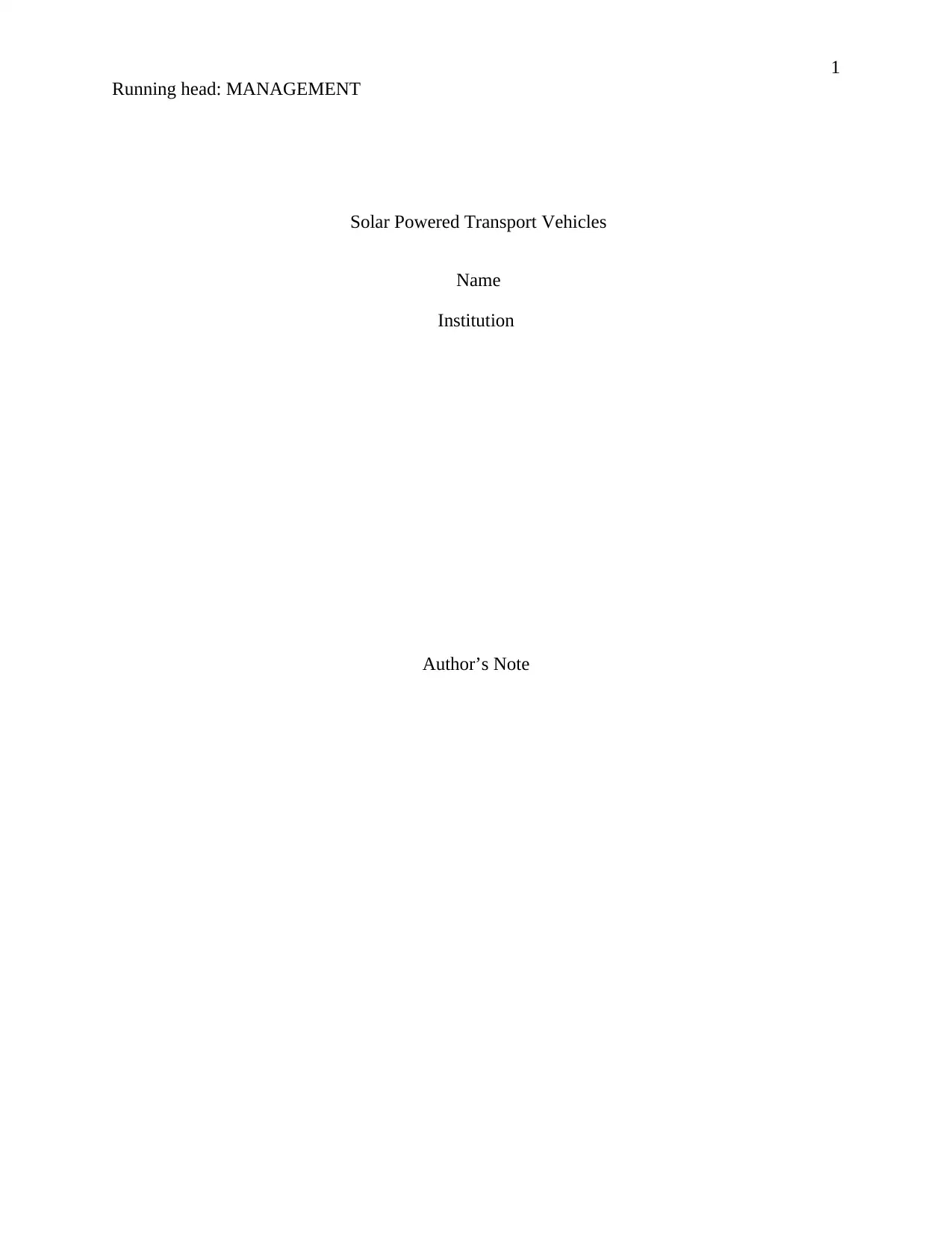
1
Running head: MANAGEMENT
Solar Powered Transport Vehicles
Name
Institution
Author’s Note
Running head: MANAGEMENT
Solar Powered Transport Vehicles
Name
Institution
Author’s Note
Paraphrase This Document
Need a fresh take? Get an instant paraphrase of this document with our AI Paraphraser
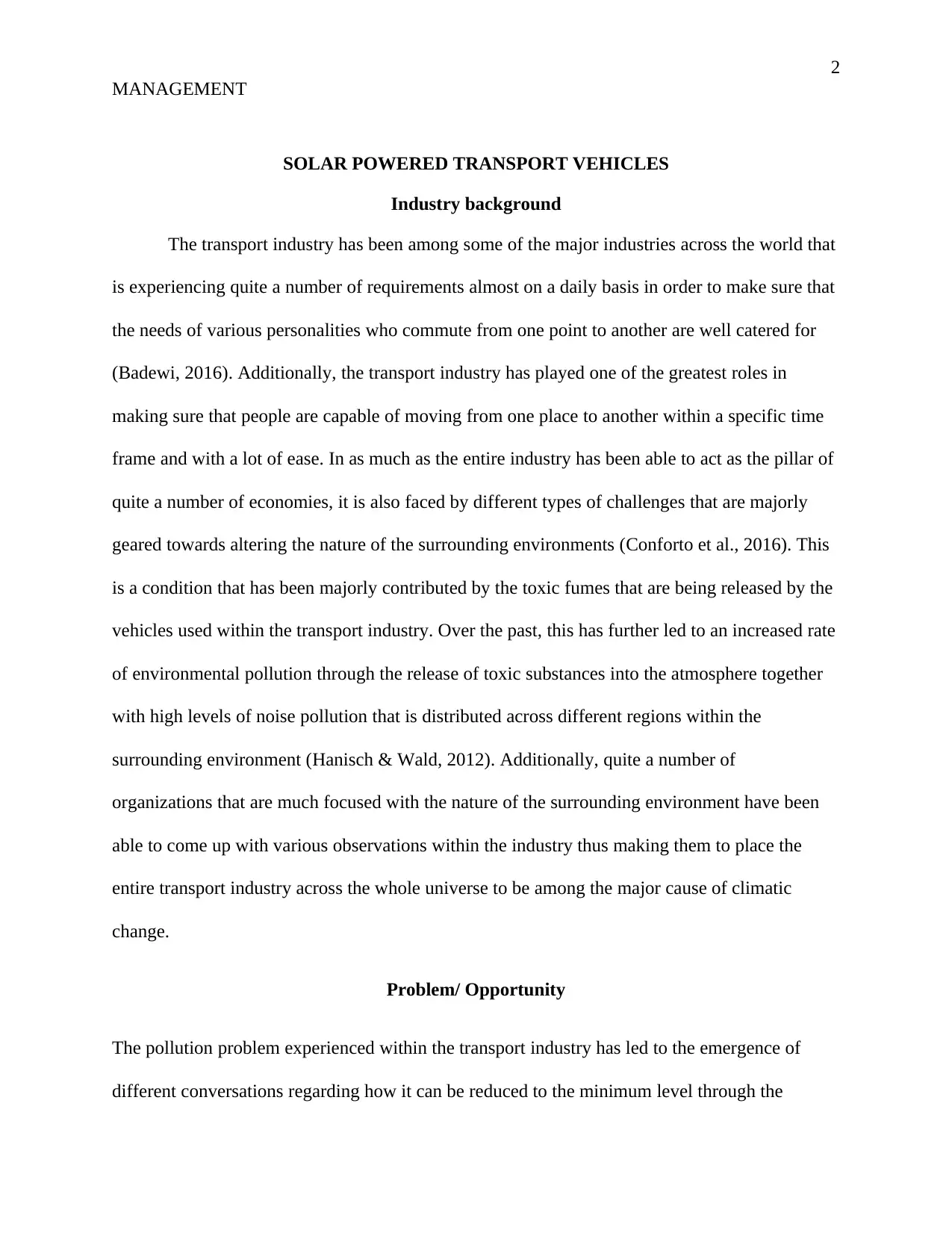
2
MANAGEMENT
SOLAR POWERED TRANSPORT VEHICLES
Industry background
The transport industry has been among some of the major industries across the world that
is experiencing quite a number of requirements almost on a daily basis in order to make sure that
the needs of various personalities who commute from one point to another are well catered for
(Badewi, 2016). Additionally, the transport industry has played one of the greatest roles in
making sure that people are capable of moving from one place to another within a specific time
frame and with a lot of ease. In as much as the entire industry has been able to act as the pillar of
quite a number of economies, it is also faced by different types of challenges that are majorly
geared towards altering the nature of the surrounding environments (Conforto et al., 2016). This
is a condition that has been majorly contributed by the toxic fumes that are being released by the
vehicles used within the transport industry. Over the past, this has further led to an increased rate
of environmental pollution through the release of toxic substances into the atmosphere together
with high levels of noise pollution that is distributed across different regions within the
surrounding environment (Hanisch & Wald, 2012). Additionally, quite a number of
organizations that are much focused with the nature of the surrounding environment have been
able to come up with various observations within the industry thus making them to place the
entire transport industry across the whole universe to be among the major cause of climatic
change.
Problem/ Opportunity
The pollution problem experienced within the transport industry has led to the emergence of
different conversations regarding how it can be reduced to the minimum level through the
MANAGEMENT
SOLAR POWERED TRANSPORT VEHICLES
Industry background
The transport industry has been among some of the major industries across the world that
is experiencing quite a number of requirements almost on a daily basis in order to make sure that
the needs of various personalities who commute from one point to another are well catered for
(Badewi, 2016). Additionally, the transport industry has played one of the greatest roles in
making sure that people are capable of moving from one place to another within a specific time
frame and with a lot of ease. In as much as the entire industry has been able to act as the pillar of
quite a number of economies, it is also faced by different types of challenges that are majorly
geared towards altering the nature of the surrounding environments (Conforto et al., 2016). This
is a condition that has been majorly contributed by the toxic fumes that are being released by the
vehicles used within the transport industry. Over the past, this has further led to an increased rate
of environmental pollution through the release of toxic substances into the atmosphere together
with high levels of noise pollution that is distributed across different regions within the
surrounding environment (Hanisch & Wald, 2012). Additionally, quite a number of
organizations that are much focused with the nature of the surrounding environment have been
able to come up with various observations within the industry thus making them to place the
entire transport industry across the whole universe to be among the major cause of climatic
change.
Problem/ Opportunity
The pollution problem experienced within the transport industry has led to the emergence of
different conversations regarding how it can be reduced to the minimum level through the
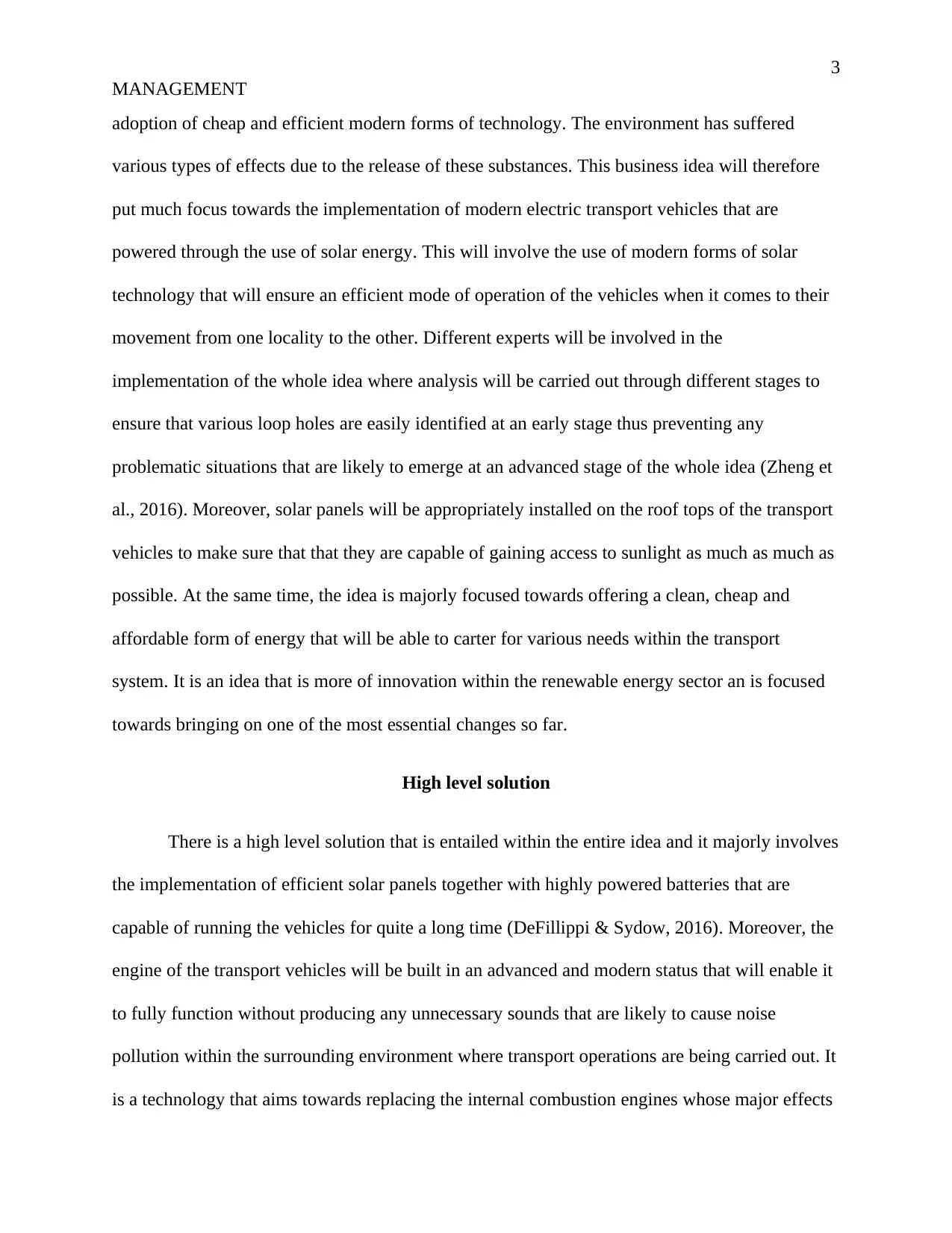
3
MANAGEMENT
adoption of cheap and efficient modern forms of technology. The environment has suffered
various types of effects due to the release of these substances. This business idea will therefore
put much focus towards the implementation of modern electric transport vehicles that are
powered through the use of solar energy. This will involve the use of modern forms of solar
technology that will ensure an efficient mode of operation of the vehicles when it comes to their
movement from one locality to the other. Different experts will be involved in the
implementation of the whole idea where analysis will be carried out through different stages to
ensure that various loop holes are easily identified at an early stage thus preventing any
problematic situations that are likely to emerge at an advanced stage of the whole idea (Zheng et
al., 2016). Moreover, solar panels will be appropriately installed on the roof tops of the transport
vehicles to make sure that that they are capable of gaining access to sunlight as much as much as
possible. At the same time, the idea is majorly focused towards offering a clean, cheap and
affordable form of energy that will be able to carter for various needs within the transport
system. It is an idea that is more of innovation within the renewable energy sector an is focused
towards bringing on one of the most essential changes so far.
High level solution
There is a high level solution that is entailed within the entire idea and it majorly involves
the implementation of efficient solar panels together with highly powered batteries that are
capable of running the vehicles for quite a long time (DeFillippi & Sydow, 2016). Moreover, the
engine of the transport vehicles will be built in an advanced and modern status that will enable it
to fully function without producing any unnecessary sounds that are likely to cause noise
pollution within the surrounding environment where transport operations are being carried out. It
is a technology that aims towards replacing the internal combustion engines whose major effects
MANAGEMENT
adoption of cheap and efficient modern forms of technology. The environment has suffered
various types of effects due to the release of these substances. This business idea will therefore
put much focus towards the implementation of modern electric transport vehicles that are
powered through the use of solar energy. This will involve the use of modern forms of solar
technology that will ensure an efficient mode of operation of the vehicles when it comes to their
movement from one locality to the other. Different experts will be involved in the
implementation of the whole idea where analysis will be carried out through different stages to
ensure that various loop holes are easily identified at an early stage thus preventing any
problematic situations that are likely to emerge at an advanced stage of the whole idea (Zheng et
al., 2016). Moreover, solar panels will be appropriately installed on the roof tops of the transport
vehicles to make sure that that they are capable of gaining access to sunlight as much as much as
possible. At the same time, the idea is majorly focused towards offering a clean, cheap and
affordable form of energy that will be able to carter for various needs within the transport
system. It is an idea that is more of innovation within the renewable energy sector an is focused
towards bringing on one of the most essential changes so far.
High level solution
There is a high level solution that is entailed within the entire idea and it majorly involves
the implementation of efficient solar panels together with highly powered batteries that are
capable of running the vehicles for quite a long time (DeFillippi & Sydow, 2016). Moreover, the
engine of the transport vehicles will be built in an advanced and modern status that will enable it
to fully function without producing any unnecessary sounds that are likely to cause noise
pollution within the surrounding environment where transport operations are being carried out. It
is a technology that aims towards replacing the internal combustion engines whose major effects
⊘ This is a preview!⊘
Do you want full access?
Subscribe today to unlock all pages.

Trusted by 1+ million students worldwide
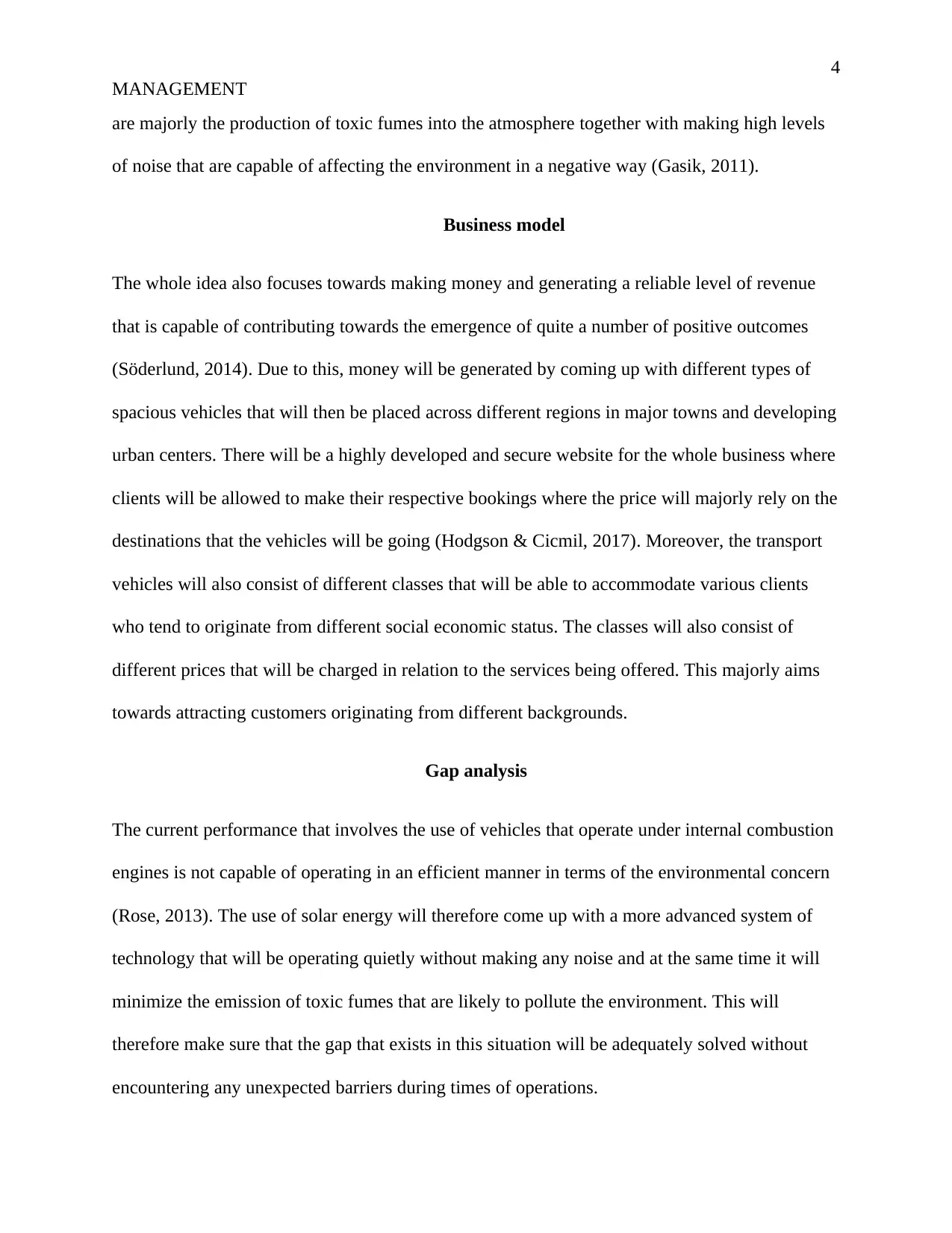
4
MANAGEMENT
are majorly the production of toxic fumes into the atmosphere together with making high levels
of noise that are capable of affecting the environment in a negative way (Gasik, 2011).
Business model
The whole idea also focuses towards making money and generating a reliable level of revenue
that is capable of contributing towards the emergence of quite a number of positive outcomes
(Söderlund, 2014). Due to this, money will be generated by coming up with different types of
spacious vehicles that will then be placed across different regions in major towns and developing
urban centers. There will be a highly developed and secure website for the whole business where
clients will be allowed to make their respective bookings where the price will majorly rely on the
destinations that the vehicles will be going (Hodgson & Cicmil, 2017). Moreover, the transport
vehicles will also consist of different classes that will be able to accommodate various clients
who tend to originate from different social economic status. The classes will also consist of
different prices that will be charged in relation to the services being offered. This majorly aims
towards attracting customers originating from different backgrounds.
Gap analysis
The current performance that involves the use of vehicles that operate under internal combustion
engines is not capable of operating in an efficient manner in terms of the environmental concern
(Rose, 2013). The use of solar energy will therefore come up with a more advanced system of
technology that will be operating quietly without making any noise and at the same time it will
minimize the emission of toxic fumes that are likely to pollute the environment. This will
therefore make sure that the gap that exists in this situation will be adequately solved without
encountering any unexpected barriers during times of operations.
MANAGEMENT
are majorly the production of toxic fumes into the atmosphere together with making high levels
of noise that are capable of affecting the environment in a negative way (Gasik, 2011).
Business model
The whole idea also focuses towards making money and generating a reliable level of revenue
that is capable of contributing towards the emergence of quite a number of positive outcomes
(Söderlund, 2014). Due to this, money will be generated by coming up with different types of
spacious vehicles that will then be placed across different regions in major towns and developing
urban centers. There will be a highly developed and secure website for the whole business where
clients will be allowed to make their respective bookings where the price will majorly rely on the
destinations that the vehicles will be going (Hodgson & Cicmil, 2017). Moreover, the transport
vehicles will also consist of different classes that will be able to accommodate various clients
who tend to originate from different social economic status. The classes will also consist of
different prices that will be charged in relation to the services being offered. This majorly aims
towards attracting customers originating from different backgrounds.
Gap analysis
The current performance that involves the use of vehicles that operate under internal combustion
engines is not capable of operating in an efficient manner in terms of the environmental concern
(Rose, 2013). The use of solar energy will therefore come up with a more advanced system of
technology that will be operating quietly without making any noise and at the same time it will
minimize the emission of toxic fumes that are likely to pollute the environment. This will
therefore make sure that the gap that exists in this situation will be adequately solved without
encountering any unexpected barriers during times of operations.
Paraphrase This Document
Need a fresh take? Get an instant paraphrase of this document with our AI Paraphraser
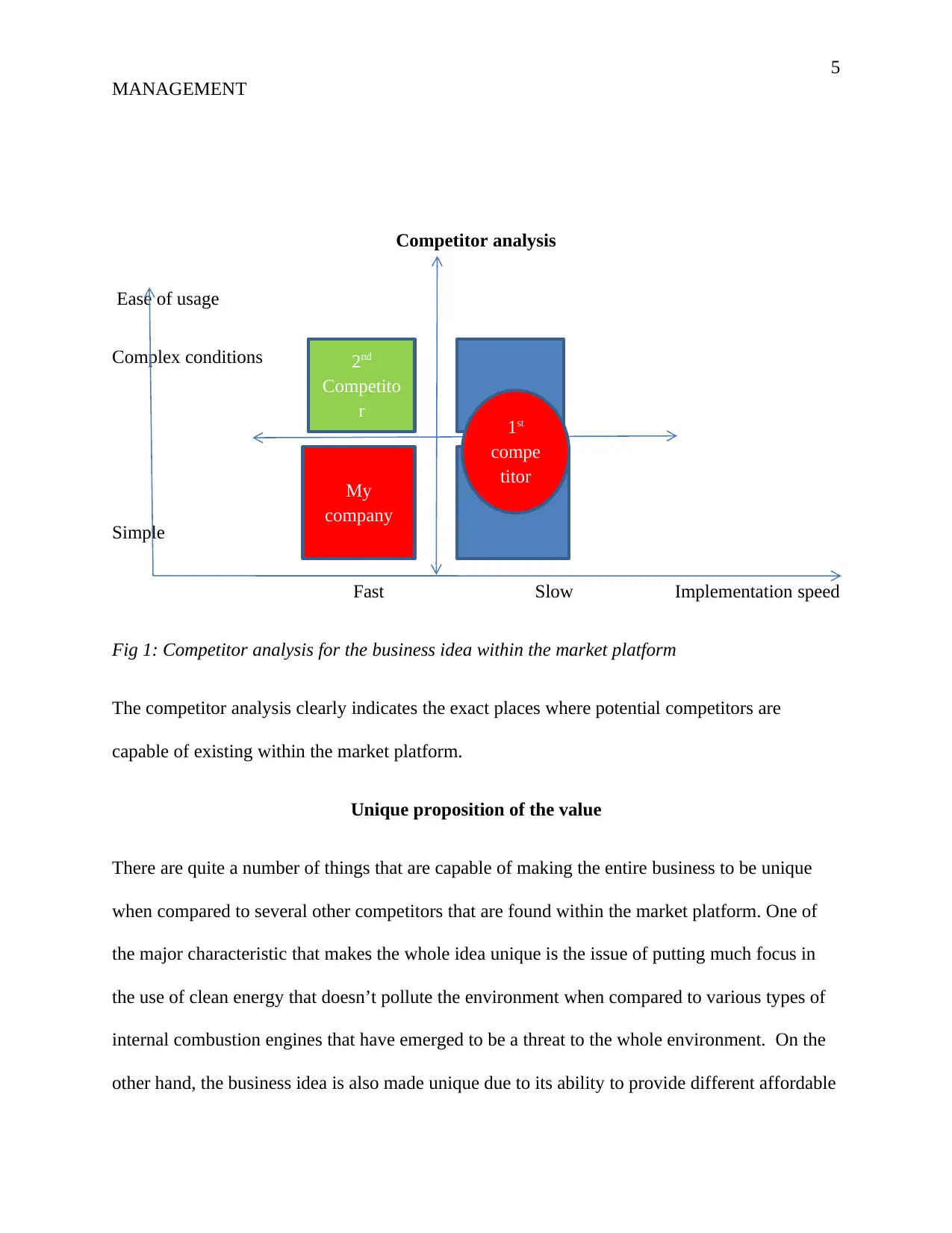
5
MANAGEMENT
Competitor analysis
Ease of usage
Complex conditions
Simple
Fast Slow Implementation speed
Fig 1: Competitor analysis for the business idea within the market platform
The competitor analysis clearly indicates the exact places where potential competitors are
capable of existing within the market platform.
Unique proposition of the value
There are quite a number of things that are capable of making the entire business to be unique
when compared to several other competitors that are found within the market platform. One of
the major characteristic that makes the whole idea unique is the issue of putting much focus in
the use of clean energy that doesn’t pollute the environment when compared to various types of
internal combustion engines that have emerged to be a threat to the whole environment. On the
other hand, the business idea is also made unique due to its ability to provide different affordable
2nd
Competito
r
My
company
1st
compe
titor
MANAGEMENT
Competitor analysis
Ease of usage
Complex conditions
Simple
Fast Slow Implementation speed
Fig 1: Competitor analysis for the business idea within the market platform
The competitor analysis clearly indicates the exact places where potential competitors are
capable of existing within the market platform.
Unique proposition of the value
There are quite a number of things that are capable of making the entire business to be unique
when compared to several other competitors that are found within the market platform. One of
the major characteristic that makes the whole idea unique is the issue of putting much focus in
the use of clean energy that doesn’t pollute the environment when compared to various types of
internal combustion engines that have emerged to be a threat to the whole environment. On the
other hand, the business idea is also made unique due to its ability to provide different affordable
2nd
Competito
r
My
company
1st
compe
titor
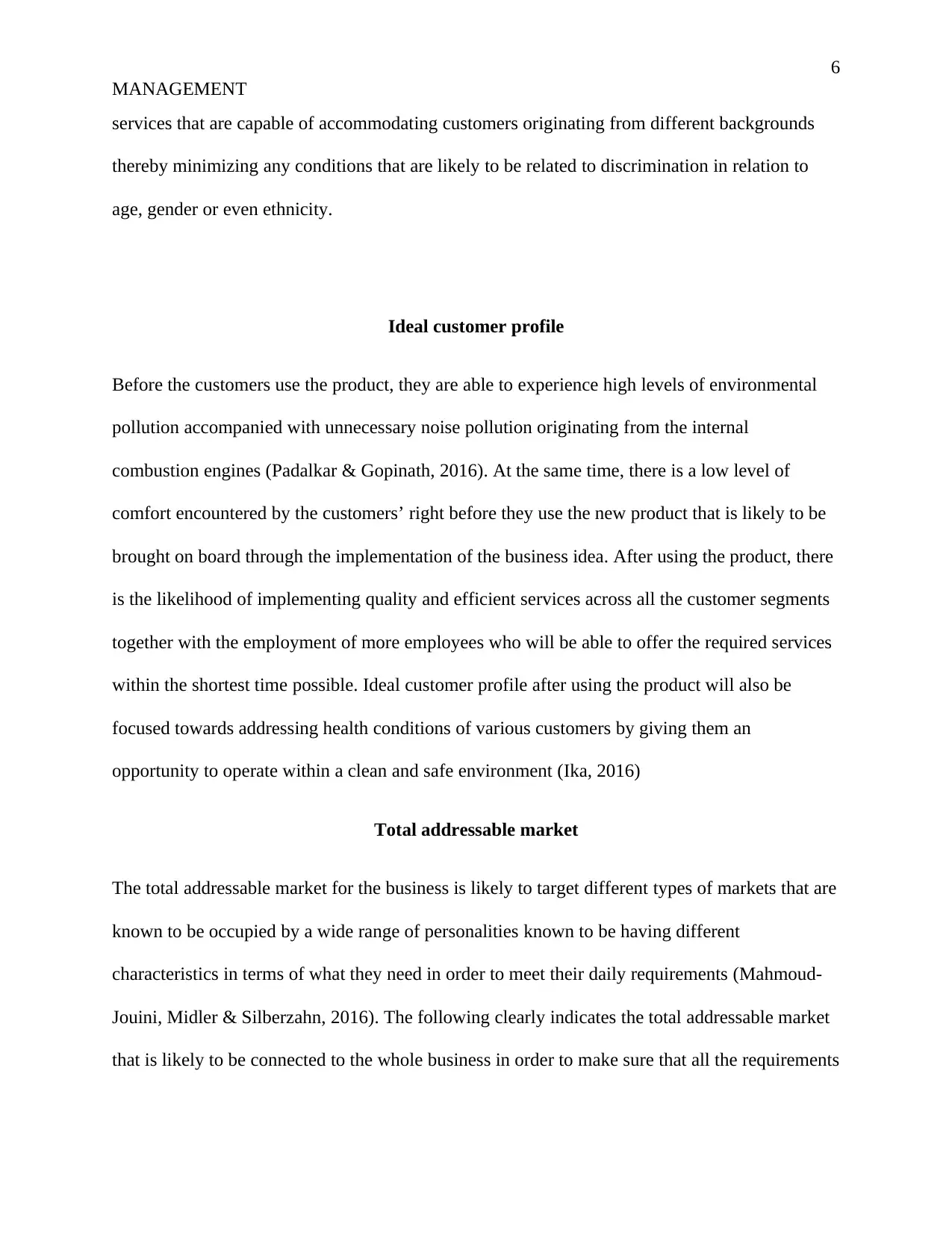
6
MANAGEMENT
services that are capable of accommodating customers originating from different backgrounds
thereby minimizing any conditions that are likely to be related to discrimination in relation to
age, gender or even ethnicity.
Ideal customer profile
Before the customers use the product, they are able to experience high levels of environmental
pollution accompanied with unnecessary noise pollution originating from the internal
combustion engines (Padalkar & Gopinath, 2016). At the same time, there is a low level of
comfort encountered by the customers’ right before they use the new product that is likely to be
brought on board through the implementation of the business idea. After using the product, there
is the likelihood of implementing quality and efficient services across all the customer segments
together with the employment of more employees who will be able to offer the required services
within the shortest time possible. Ideal customer profile after using the product will also be
focused towards addressing health conditions of various customers by giving them an
opportunity to operate within a clean and safe environment (Ika, 2016)
Total addressable market
The total addressable market for the business is likely to target different types of markets that are
known to be occupied by a wide range of personalities known to be having different
characteristics in terms of what they need in order to meet their daily requirements (Mahmoud-
Jouini, Midler & Silberzahn, 2016). The following clearly indicates the total addressable market
that is likely to be connected to the whole business in order to make sure that all the requirements
MANAGEMENT
services that are capable of accommodating customers originating from different backgrounds
thereby minimizing any conditions that are likely to be related to discrimination in relation to
age, gender or even ethnicity.
Ideal customer profile
Before the customers use the product, they are able to experience high levels of environmental
pollution accompanied with unnecessary noise pollution originating from the internal
combustion engines (Padalkar & Gopinath, 2016). At the same time, there is a low level of
comfort encountered by the customers’ right before they use the new product that is likely to be
brought on board through the implementation of the business idea. After using the product, there
is the likelihood of implementing quality and efficient services across all the customer segments
together with the employment of more employees who will be able to offer the required services
within the shortest time possible. Ideal customer profile after using the product will also be
focused towards addressing health conditions of various customers by giving them an
opportunity to operate within a clean and safe environment (Ika, 2016)
Total addressable market
The total addressable market for the business is likely to target different types of markets that are
known to be occupied by a wide range of personalities known to be having different
characteristics in terms of what they need in order to meet their daily requirements (Mahmoud-
Jouini, Midler & Silberzahn, 2016). The following clearly indicates the total addressable market
that is likely to be connected to the whole business in order to make sure that all the requirements
⊘ This is a preview!⊘
Do you want full access?
Subscribe today to unlock all pages.

Trusted by 1+ million students worldwide
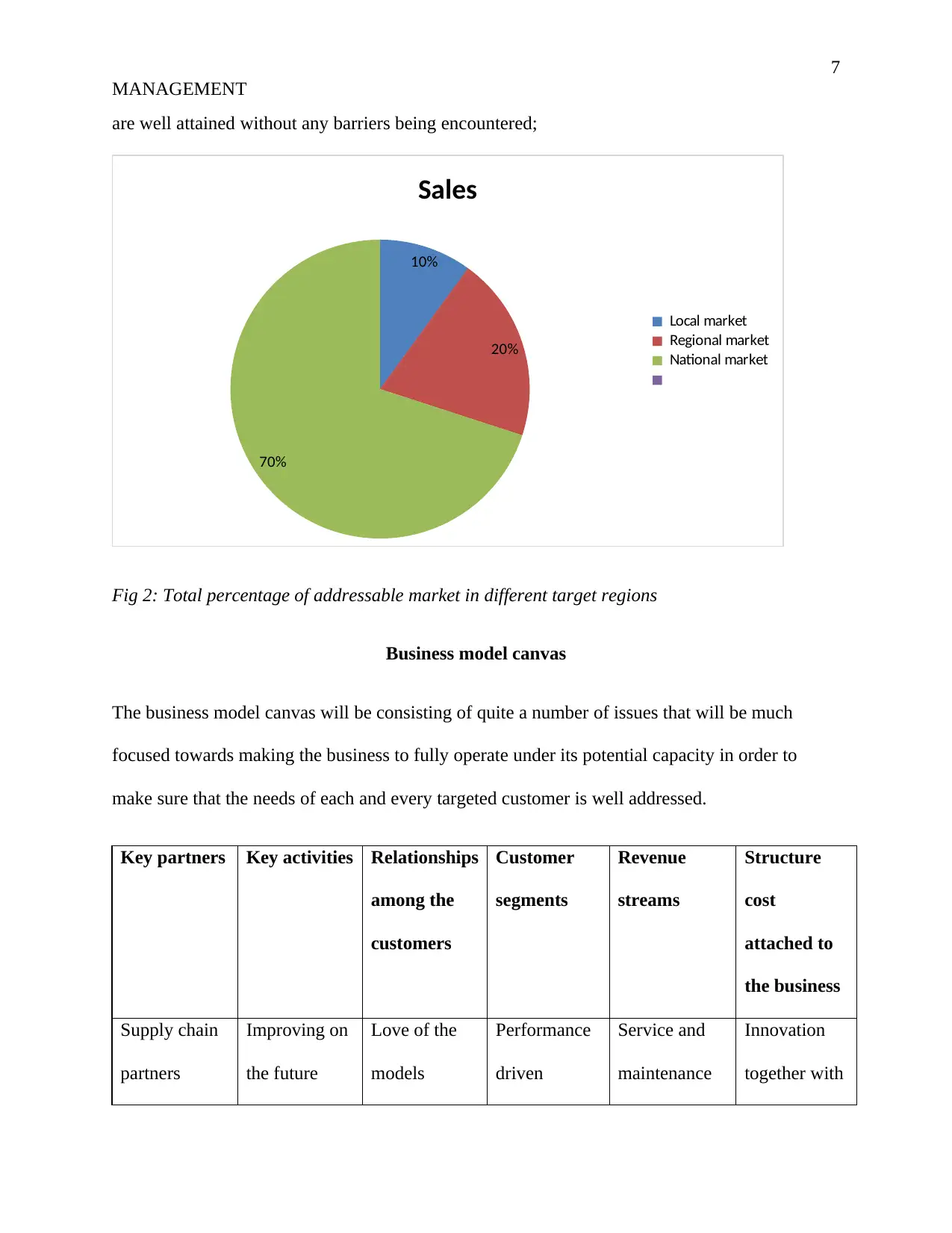
7
MANAGEMENT
are well attained without any barriers being encountered;
10%
20%
70%
Sales
Local market
Regional market
National market
Fig 2: Total percentage of addressable market in different target regions
Business model canvas
The business model canvas will be consisting of quite a number of issues that will be much
focused towards making the business to fully operate under its potential capacity in order to
make sure that the needs of each and every targeted customer is well addressed.
Key partners Key activities Relationships
among the
customers
Customer
segments
Revenue
streams
Structure
cost
attached to
the business
Supply chain
partners
Improving on
the future
Love of the
models
Performance
driven
Service and
maintenance
Innovation
together with
MANAGEMENT
are well attained without any barriers being encountered;
10%
20%
70%
Sales
Local market
Regional market
National market
Fig 2: Total percentage of addressable market in different target regions
Business model canvas
The business model canvas will be consisting of quite a number of issues that will be much
focused towards making the business to fully operate under its potential capacity in order to
make sure that the needs of each and every targeted customer is well addressed.
Key partners Key activities Relationships
among the
customers
Customer
segments
Revenue
streams
Structure
cost
attached to
the business
Supply chain
partners
Improving on
the future
Love of the
models
Performance
driven
Service and
maintenance
Innovation
together with
Paraphrase This Document
Need a fresh take? Get an instant paraphrase of this document with our AI Paraphraser
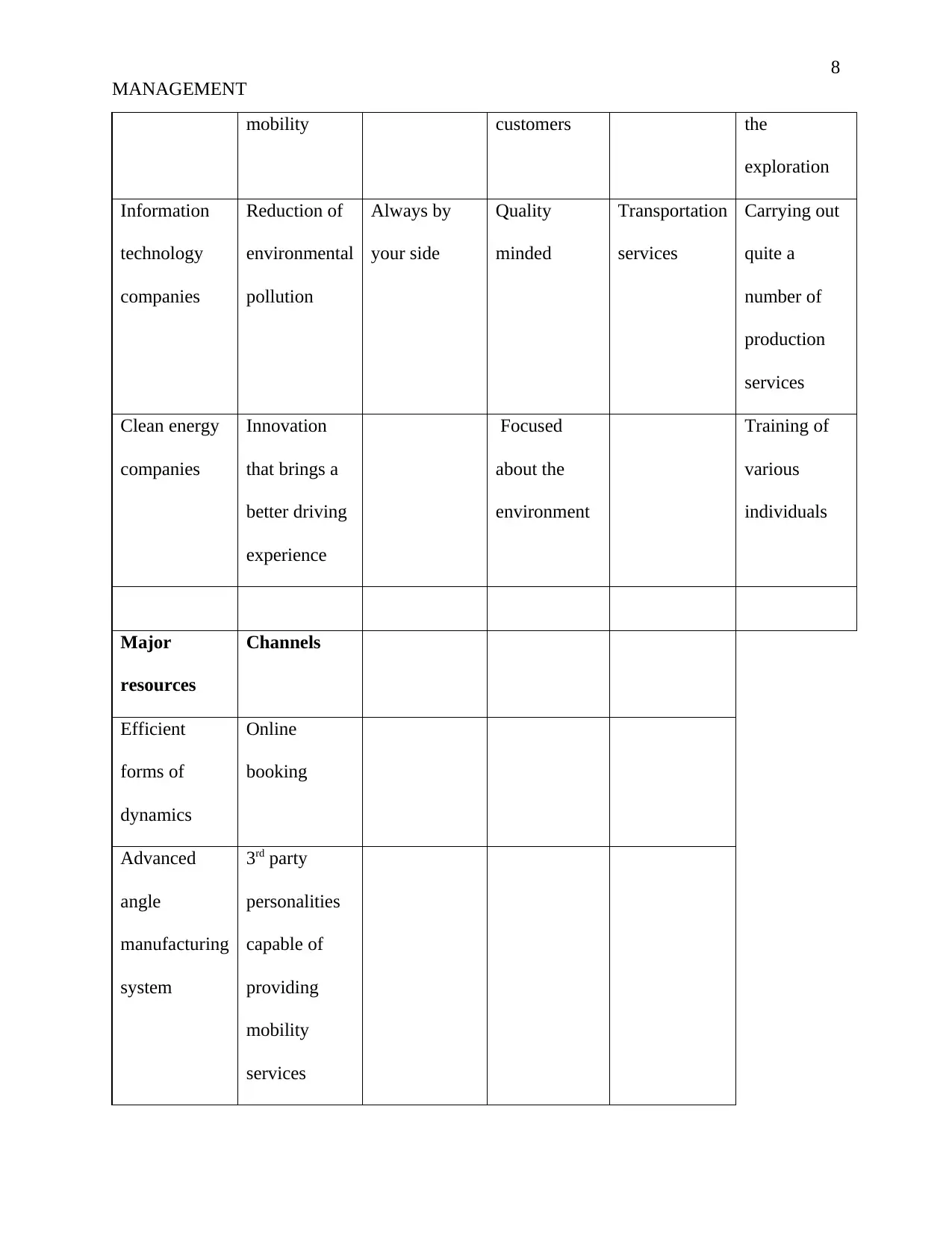
8
MANAGEMENT
mobility customers the
exploration
Information
technology
companies
Reduction of
environmental
pollution
Always by
your side
Quality
minded
Transportation
services
Carrying out
quite a
number of
production
services
Clean energy
companies
Innovation
that brings a
better driving
experience
Focused
about the
environment
Training of
various
individuals
Major
resources
Channels
Efficient
forms of
dynamics
Online
booking
Advanced
angle
manufacturing
system
3rd party
personalities
capable of
providing
mobility
services
MANAGEMENT
mobility customers the
exploration
Information
technology
companies
Reduction of
environmental
pollution
Always by
your side
Quality
minded
Transportation
services
Carrying out
quite a
number of
production
services
Clean energy
companies
Innovation
that brings a
better driving
experience
Focused
about the
environment
Training of
various
individuals
Major
resources
Channels
Efficient
forms of
dynamics
Online
booking
Advanced
angle
manufacturing
system
3rd party
personalities
capable of
providing
mobility
services
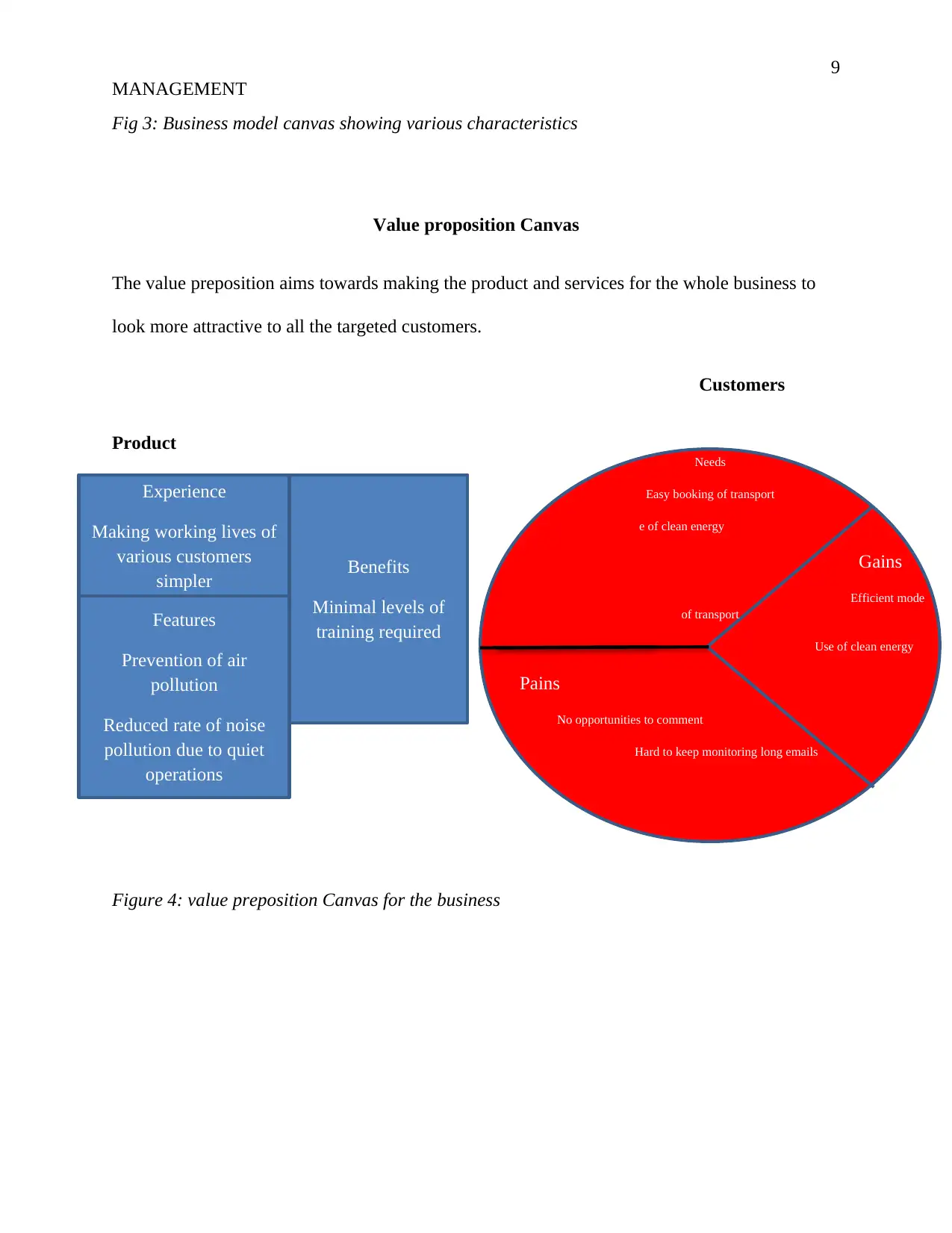
9
MANAGEMENT
Fig 3: Business model canvas showing various characteristics
Value proposition Canvas
The value preposition aims towards making the product and services for the whole business to
look more attractive to all the targeted customers.
Customers
Product
Figure 4: value preposition Canvas for the business
Benefits
Minimal levels of
training required
Features
Prevention of air
pollution
Reduced rate of noise
pollution due to quiet
operations
Experience
Making working lives of
various customers
simpler
Needs
Easy booking of transport
Us e of clean energy
Gains
Efficient mode
of transport
Use of clean energy
Pains
No opportunities to comment
Hard to keep monitoring long emails
MANAGEMENT
Fig 3: Business model canvas showing various characteristics
Value proposition Canvas
The value preposition aims towards making the product and services for the whole business to
look more attractive to all the targeted customers.
Customers
Product
Figure 4: value preposition Canvas for the business
Benefits
Minimal levels of
training required
Features
Prevention of air
pollution
Reduced rate of noise
pollution due to quiet
operations
Experience
Making working lives of
various customers
simpler
Needs
Easy booking of transport
Us e of clean energy
Gains
Efficient mode
of transport
Use of clean energy
Pains
No opportunities to comment
Hard to keep monitoring long emails
⊘ This is a preview!⊘
Do you want full access?
Subscribe today to unlock all pages.

Trusted by 1+ million students worldwide
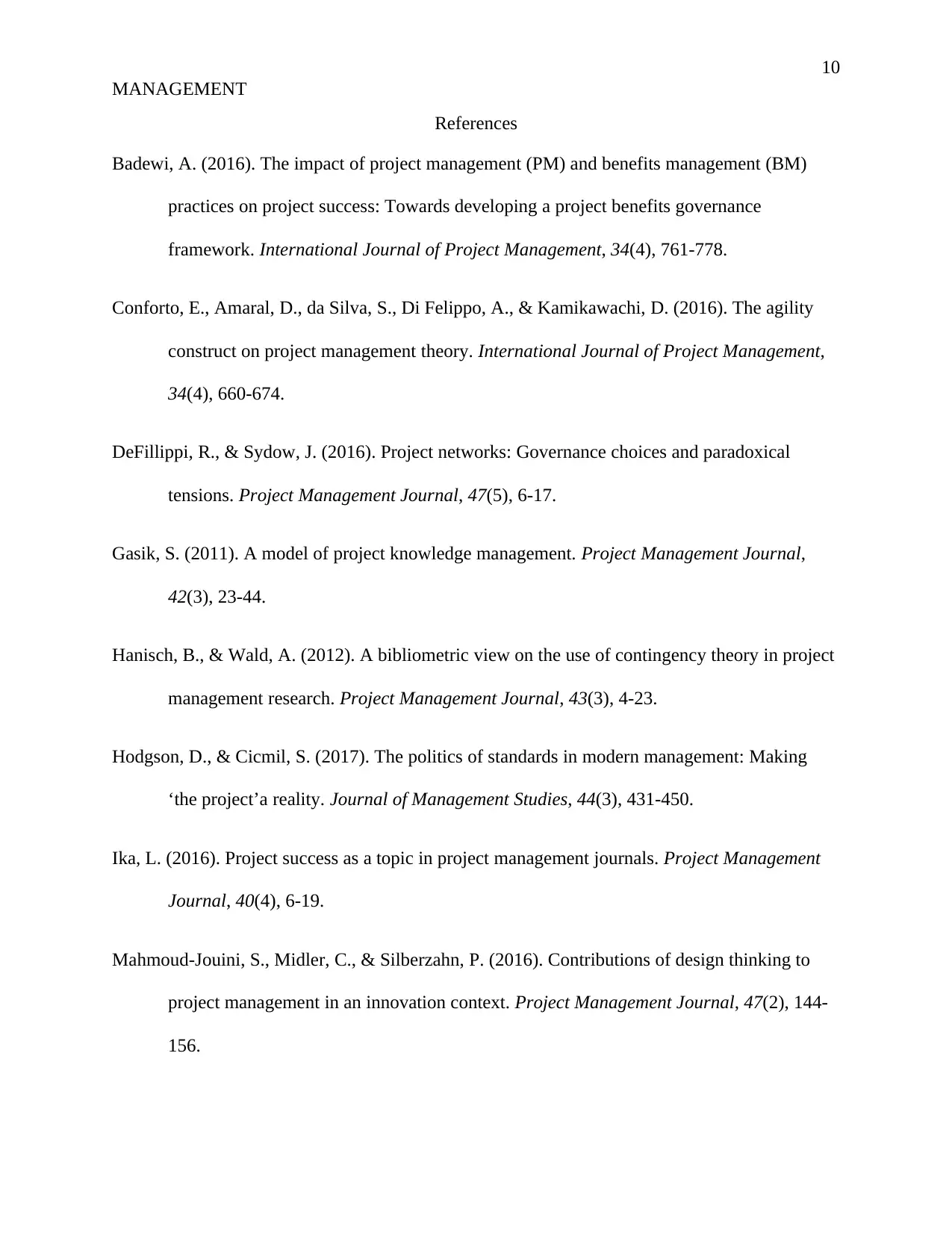
10
MANAGEMENT
References
Badewi, A. (2016). The impact of project management (PM) and benefits management (BM)
practices on project success: Towards developing a project benefits governance
framework. International Journal of Project Management, 34(4), 761-778.
Conforto, E., Amaral, D., da Silva, S., Di Felippo, A., & Kamikawachi, D. (2016). The agility
construct on project management theory. International Journal of Project Management,
34(4), 660-674.
DeFillippi, R., & Sydow, J. (2016). Project networks: Governance choices and paradoxical
tensions. Project Management Journal, 47(5), 6-17.
Gasik, S. (2011). A model of project knowledge management. Project Management Journal,
42(3), 23-44.
Hanisch, B., & Wald, A. (2012). A bibliometric view on the use of contingency theory in project
management research. Project Management Journal, 43(3), 4-23.
Hodgson, D., & Cicmil, S. (2017). The politics of standards in modern management: Making
‘the project’a reality. Journal of Management Studies, 44(3), 431-450.
Ika, L. (2016). Project success as a topic in project management journals. Project Management
Journal, 40(4), 6-19.
Mahmoud-Jouini, S., Midler, C., & Silberzahn, P. (2016). Contributions of design thinking to
project management in an innovation context. Project Management Journal, 47(2), 144-
156.
MANAGEMENT
References
Badewi, A. (2016). The impact of project management (PM) and benefits management (BM)
practices on project success: Towards developing a project benefits governance
framework. International Journal of Project Management, 34(4), 761-778.
Conforto, E., Amaral, D., da Silva, S., Di Felippo, A., & Kamikawachi, D. (2016). The agility
construct on project management theory. International Journal of Project Management,
34(4), 660-674.
DeFillippi, R., & Sydow, J. (2016). Project networks: Governance choices and paradoxical
tensions. Project Management Journal, 47(5), 6-17.
Gasik, S. (2011). A model of project knowledge management. Project Management Journal,
42(3), 23-44.
Hanisch, B., & Wald, A. (2012). A bibliometric view on the use of contingency theory in project
management research. Project Management Journal, 43(3), 4-23.
Hodgson, D., & Cicmil, S. (2017). The politics of standards in modern management: Making
‘the project’a reality. Journal of Management Studies, 44(3), 431-450.
Ika, L. (2016). Project success as a topic in project management journals. Project Management
Journal, 40(4), 6-19.
Mahmoud-Jouini, S., Midler, C., & Silberzahn, P. (2016). Contributions of design thinking to
project management in an innovation context. Project Management Journal, 47(2), 144-
156.
Paraphrase This Document
Need a fresh take? Get an instant paraphrase of this document with our AI Paraphraser
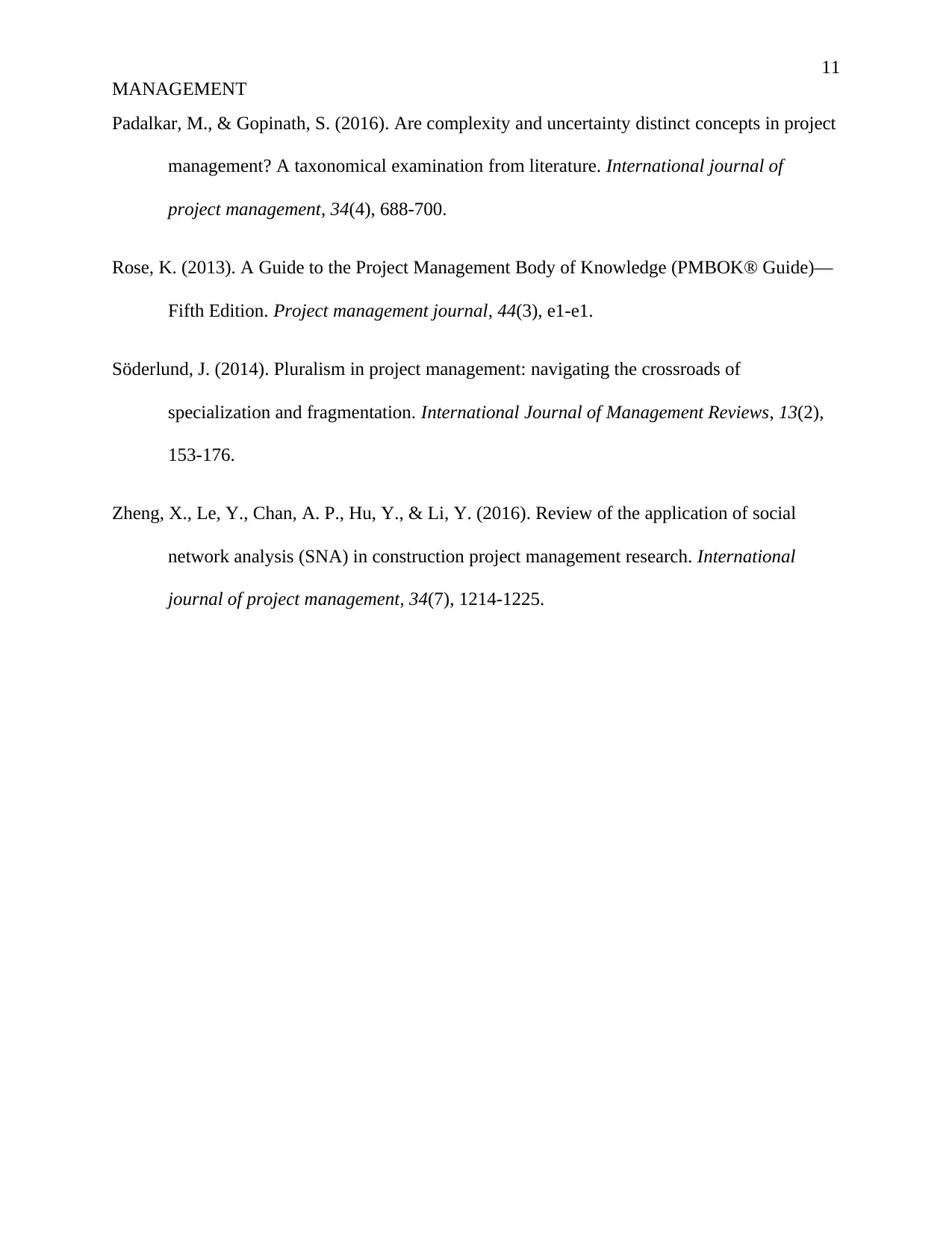
11
MANAGEMENT
Padalkar, M., & Gopinath, S. (2016). Are complexity and uncertainty distinct concepts in project
management? A taxonomical examination from literature. International journal of
project management, 34(4), 688-700.
Rose, K. (2013). A Guide to the Project Management Body of Knowledge (PMBOK® Guide)—
Fifth Edition. Project management journal, 44(3), e1-e1.
Söderlund, J. (2014). Pluralism in project management: navigating the crossroads of
specialization and fragmentation. International Journal of Management Reviews, 13(2),
153-176.
Zheng, X., Le, Y., Chan, A. P., Hu, Y., & Li, Y. (2016). Review of the application of social
network analysis (SNA) in construction project management research. International
journal of project management, 34(7), 1214-1225.
MANAGEMENT
Padalkar, M., & Gopinath, S. (2016). Are complexity and uncertainty distinct concepts in project
management? A taxonomical examination from literature. International journal of
project management, 34(4), 688-700.
Rose, K. (2013). A Guide to the Project Management Body of Knowledge (PMBOK® Guide)—
Fifth Edition. Project management journal, 44(3), e1-e1.
Söderlund, J. (2014). Pluralism in project management: navigating the crossroads of
specialization and fragmentation. International Journal of Management Reviews, 13(2),
153-176.
Zheng, X., Le, Y., Chan, A. P., Hu, Y., & Li, Y. (2016). Review of the application of social
network analysis (SNA) in construction project management research. International
journal of project management, 34(7), 1214-1225.
1 out of 11
Your All-in-One AI-Powered Toolkit for Academic Success.
+13062052269
info@desklib.com
Available 24*7 on WhatsApp / Email
![[object Object]](/_next/static/media/star-bottom.7253800d.svg)
Unlock your academic potential
Copyright © 2020–2025 A2Z Services. All Rights Reserved. Developed and managed by ZUCOL.


